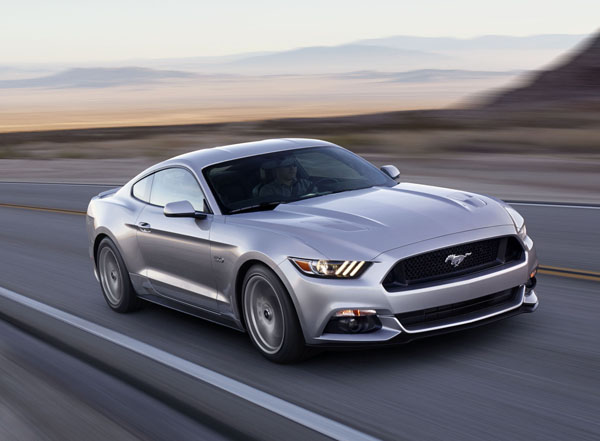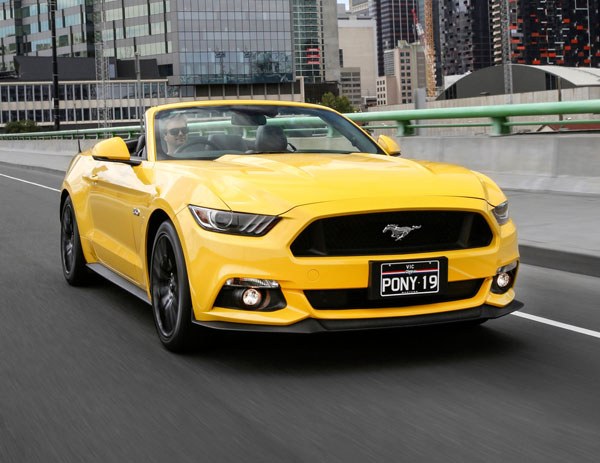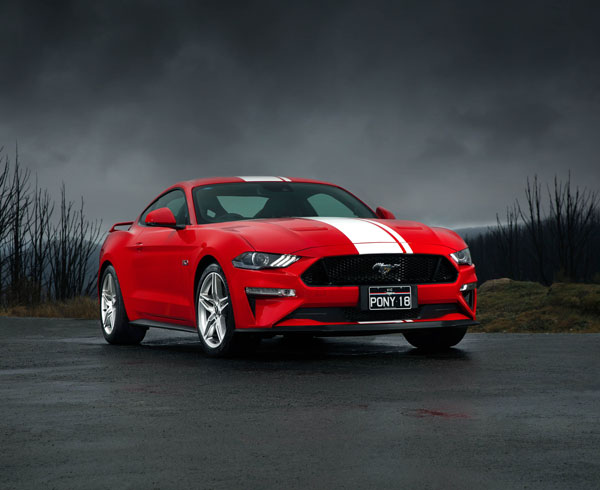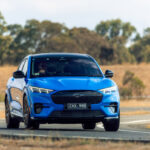What a success story! Like quite a few others I made the mistake of thinking Ford Mustang would sell like hot cakes for a year or so, but then slowly fade from the scene. Instead it’s continues to be a favourite and I see them pretty well every time I’m on the road. Excellent…
The latest iteration of the Mustang, launched Downunder in December 1015 comes in two versions, coupe and convertible, powered by either a 5.0-litre V8 or four-cylinder 2.3-litre EcoBoost engine, the former a nod to the 20th century gas guzzling muscle machines, the latter Ford’s gift to environmentally conscious modern motoring.
The 5.0-litre V8 featured lessons learned in developing the special-edition 2012 Mustang Boss 302. The result is a boost in power to 306 kW and 530 Nm of torque.
The addition of the 2.3-litre EcoBoost engine introduces turbocharging to the Mustang powertrain line-up. Once again engine breathing is the key, the geometry of the EcoBoost intake manifold and turbocharger housing being optimised to provide higher output – 233 kW and 432 Nm of torque.
Six-speed manual transmission provides smoother shifting than previous Mustangs, while the automatic transmission features steering wheel-mounted paddle shifters and downshift rev-matching.
Steering feel is nicely weighted with just the right heft for keen drivers of high-performance machines. The four-cylinder EcoBoost engine is nice and short and sits well back under the long bonnet. It pretty well straddles the front axle area so provides excellent balance.
Seats are laterally supportive but lack of rear legroom puts the Mustang well into 2+2 territory.
A selection of driving modes can be called up by flicking a switch on the central console. Normal offers a balance between comfort and performance; Sport+ provides more responsive steering and throttle response; Track allows the engine to respond directly to the driver’s input, while reinforcing the sporty engine note; and Snow / Wet keeps the car in touch with adverse road conditions.Convertible cabin wind turbulence was non-intrusive with the top down, with the body strength coping well with lateral and twisting forces.
January 2018 saw Ford Australia launch what it called, ‘The Fastest Mustang Ever.’ The 5.0-litre V8 engine was thoroughly reworked to develops 450 horsepower (339 kW). This was achieved with the first application of Ford’s dual-fuel, high-pressure direct-injection and low-pressure port fuel injection. The result is solid low-end torque, high-rpm power, and improved fuel efficiency. Peak torque is now 556 Nm.
At the same time the mildly revised 2.3-litre EcoBoost unit developed 300 horsepower (224 kW). It had nine Nm more torque, now 441 Nm.
Biggest news is behind the engines where a new 10-speed automatic is offered with both Mustang engines. It has a wide-ratio span between first and tenth, faster shifts and optimised gear spacing to keep it at peak torque, and fast response. Steering wheel-mounted shift paddles give drivers manual control.
The six-speed manual gearboxes were upgraded to handle the added torque on both engines.
Mustang’s engine note could be adjusted. An active valve exhaust system is standard on all GT models. Four modes are available: Normal, Quiet, Track and Sport.
Visually, there’s a lower, remodelled bonnet with air intakes in new positions and revised upper and lower front grilles. But it still looks very much like a Mustang.
Revised shock absorbers make for better ride control, while a new cross-axis joint in the rear suspension leads to increased lateral stiffness. The stabiliser bars have also been revised.
For the first time, MagneRide damper technology was an option for Mustang, designed to optimise ride and handling in all situations. Previously exclusive to the Mustang Shelby GT350, the system allows automatic adjustment of each corner, up to 1000 times per second, for even better responsiveness and lateral performance.
Inside, the 2018 Mustangs have a 12-inch all-digital instrument cluster that offers three separate views – Normal, Sport and Track modes – and the ability to change colours and gauge layout.
The centre console adds a new hand-stitched wrap with contrast stitching and padded knee bolsters while door handles, rings and bezels are finished in aluminium.
Standard seats feature new patterns, six-way leather-trimmed Recaro sports are a factory-fitted option.
Obviously there are plenty of Ford dealers Australia wide, even in remote areas. Spares for Mustangs may not be held in smaller dealerships, but can usually be shipped to them within a few working days.
Insurance is surprisingly moderate in cost – if you have a good driving record and minimal previous claims. As always, shop around but be aware that a long standing record with one company can be to your benefit.
COMMENT
It makes sense to buy a four-cylinder Mustang rather than a V8. Why? Because the V8s are often used for unofficial, or even official, drag racing, so may have a lot of driveline wear. Whereas very few fours ever go to tracks to be fanged.
So would I by a turbo-four? No way!
WHAT TO LOOK FOR
A professional inspection really is a must of a car like the Ford Mustang. As is a full service history, preferably at a Ford dealer.
See my comments above about V8s being thrashed. Signs are serious rear tyre wear and lots of brake dust.
Check the the fluid on the automatic’s dipstick. If it smells burnt and looks dark, that’s another sign of hard driving. The 10-speed auto seems to stand up better than the six-speed.
Convertibles are generally water tight, but it still pays to look and feel for dampness in the carpets as on open-top Mustang may have been caught with its top down in the rain.
Look for signs of previous crash repairs, wrinkles in the panels when viewed end on, mismatched paint colours and overspray on unpainted parts.
If there’s too much turbo lag on the 2.3 EcoBoost there could be electronic tuning problems.
HOW MUCH?
Budget on spending from $21,000 to $29,000 for a 2015 Ford Mustang 2.3 Coupe; $24,000 to $32,000 for a 2016 2.3 Coupe; $27,000 to $35,000 for a 2018 2.3 Coupe; $34,000 to $46,000 for a 2016 GT Convertible; $37,000 to $48,000 for a 2017 GT Convertible; $41,000 to $55,000 for a 2018 GT Coupe; and $46,000 to $61,000 for a 2018 Bullitt Coupe.
CAR BUYING TIP
Much as we love open top cars the lower rigidity of their bodies and the chances of the interior being sun and/or damage can make them depreciate faster.
RECALLS: To browse recalls on all vehicles go to the ACCC at: www.productsafety.gov.au/products/transport/cars/














